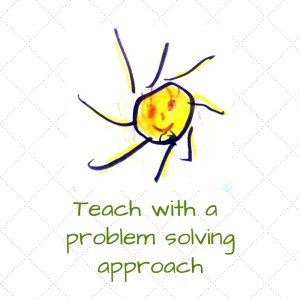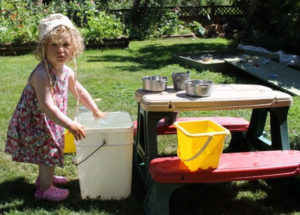KINDERGARTEN PROBLEM SOLVING
 It’s easy to add preschool and kindergarten problem solving type activities to your daily routines.
It’s easy to add preschool and kindergarten problem solving type activities to your daily routines.
Learning how to approach and solve problems early in life, not only helps children enjoy and look forward to sorting them out, it also helps them make and keep friends.
Preschool and kindergarten problem solving activities give children an opportunity to use skills they have learned previously and give you an opening to teach new problem solving strategies.
Introduce the vocabulary of solving problems with stories, puppets and everyday situations that occur. “We only have 10 apples but there are 20 students. This is a problem. Let’s think of some ways that we can solve this problem?”
Use terms like, “a different way, let’s brainstorm, that’s a challenge, let’s think of some different solutions”.
How do I develop a problem solving approach?
Asking children questions such as , “How would you…?” or “Show me how you could…?”, help set the stage for teaching with a problem solving approach. Keep problem solving topics about subjects that interest the students. Kids are constantly trying to problem solve as they play.
Students are learning to:
- Identify problems or challenges
- Fact find (what do I know, what have I tried)
- Think of ways to solve the problem (brainstorm, creative thinking, generate ideas)
- Test their ideas
What preschool and kindergarten problem solving strategies can I teach?
Young children need real objects, pictures, diagrams, and models to solve problems. Start with real objects and move slowly to diagrams and pictures. Any of the following problem solving strategies will help them work through the four steps above:
- using objects
- acting the problem out
- looking for patterns
- guessing and checking
- drawing pictures
- making a graph
- teach with projects
Play creates classroom opportunities for problem solving
 Play creates many opportunities for preschool and kindergarten problem solving. Watch your students during center times and help them find the vocabulary to identify their problems, come up with solutions and test their ideas.
Play creates many opportunities for preschool and kindergarten problem solving. Watch your students during center times and help them find the vocabulary to identify their problems, come up with solutions and test their ideas.
Perhaps a child is getting frustrated as he/she plays with blocks. To help him/her focus on the problem ask questions such as:
- What are you trying to do with your blocks?
- What isn’t working?
- What have you tried?
- Can you think of another way to stack the blocks?
- What else can you try?
Encourage creative thinking
Reinforce creative thinking, not results. The ability to solve problems and think creativity is important.
Talk about the different ways the child tried to solve the problem rather than the outcome. “Joe tried three different ways to stack the blocks. That was a great effort, Joe.”
Social classroom problem solving opportunities are abundant
- Identify the problem – Talk about the problem. For instance, some children may be worried because other kids are hiding the center markers for the play center and giving them to their friends. Other kids are not getting turns.
- Fact find – There are only 4 center markers for the play center because it is small and more than 4 kids would be too crowded. Some kids are hiding them so they can play with the same children each time.
- Brainstorm ideas – How can everyone have turns? What ideas do you have? What could we try?
- Test the idea – Let’s try that idea and meet again tomorrow and see how its working.
SHIJINA RIJESH

